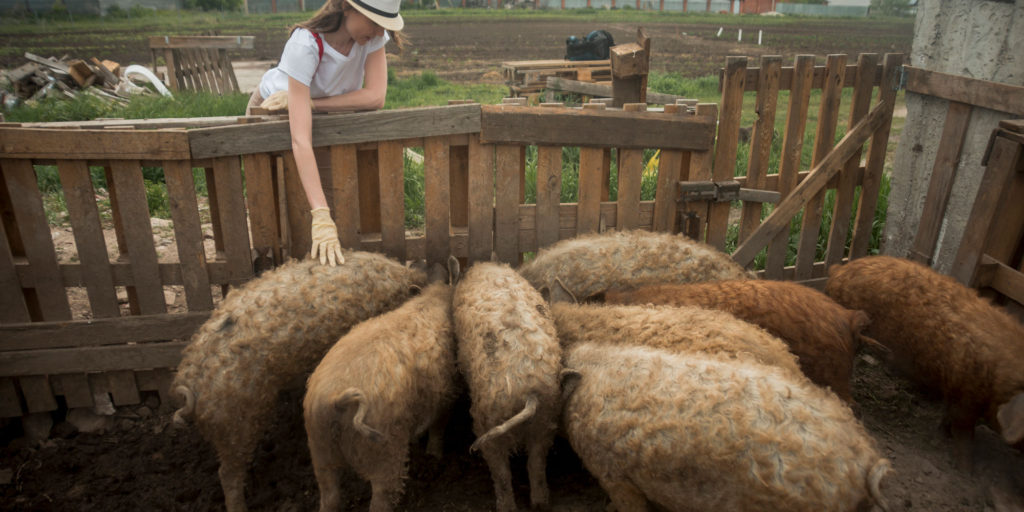Fishmeal is a brown powder obtained after cooking, pressing, drying and milling fresh pelagic fishes and left-over material from fish processing industries. Fishmeal typically contains 60%-72% protein, 10%-20% ash, and 5%-12% fat. That is why fishmeal has historically been used to feed newly weaned pigs. Other than protein, it provides fatty acids, minerals and vitamins also.
Nutritional needs of pigs can be classified into six classes. These are water, carbohydrates, fats, proteins and vitamins and minerals. Pigs are not given meat, carcasses and fish type meals, so there was a need to develop a diet that serves as a complete diet. The fishmeal and fish oil industries are one of the few major animal industries existing today that still relies on a hunting-and-gathering technique. Contrary to recent popular beliefs, most fishmeal and fish oil is produced from sustainable, managed and monitored fish stock. As per fishmeal producers, Approximately 4 to 5 tons of whole fish are required to produce 1 ton of fishmeal.
History
- The use of herring (a fairly small silver colored fish in coastal water) as an industrial raw material started as early as 800 AD in Norway, a very primary process of extracting oil from herring by pressing with the help of wooden boards and stones was adopted.
- With the spread of awareness about the advantages of feeding the animals with fishmeal, growers started feeding the poultry, pigs and other farmed fish to obtain better growth and fast reproduction.
- Till 2010, about 56% of fishmeal was used to feed the farmed fish, about 20% was used in pig feed, 12% in poultry and 12% in fertilizer industry.
Benefits of using fishmeal in pig farms:
- The role in facilitating in breeding and over feeding of millions of pigs and poultry is criticized by animal rights and animal welfare groups. Manufacturers of fishmeal counter that fishmeal’s role in the breeding and feeding of millions of farm animals, especially pigs, leads to the production of more food to fulfill the increasing population needs.
- Feeding the pregnant pigs with fishmeal and fish oil from day 95 to parturition to provide 12% of the dietary energy, heaviest piglets produced compared with the standard diet of similar energy, milk fat content increased by 12% and lower mortality rate at weaning.
- Fishmeal feed also has effects in increasing reproduction ability of pigs. Fish lipids appear to increase levels of progesterone to improve embryo survival.
- A high quality fishmeal provides a balanced amount of polyunsaturated fatty acids in terms of omega-3 and omega-6 which cannot be synthesized in the animal body and supplied through diet.
- PUFA’s are produced by phytoplankton and zooplankton on which fish feed. It is used to boost EPA and DHA levels in meat, which in turn, is important for humans. Fish lipids are more effective than vegetable lipids.
- Commonly, fish soluble are used as feed for the newly weaned pigs. Fish soluble is the byproduct derived from the intermediate fraction generated during the manufacturing process of fishmeal and fish oil. Fish soluble is the best to feed pigs’ nursery as a protein source. Fishmeal produced and marketed today containing the average 15-18% of fish soluble.
- Fishmeal contains 17%-25% ash contents. More ash contents means more amounts of minerals and vitamins, especially calcium, magnesium and phosphorus. All these minerals have key importance in pig body development like calcium is important in development of bones, helping muscles to move and nerves to send messages between the brain and every body part.
- Then comes the phosphorus, it is very important for growth and development of body, repair cells and tissues. On the other hand potassium is needed to help nerves to function and muscles to contract. It helps to minimize sodium’s harmful effects on the body, move nutrients into cells and waste out of the cells.

